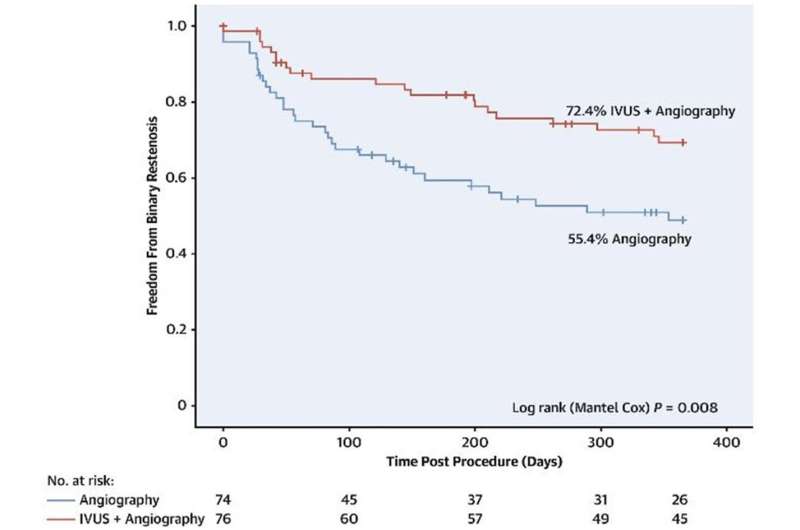This article has been reviewed according to Science X's editorial process and policies. Editors have highlighted the following attributes while ensuring the content's credibility:
fact-checked
peer-reviewed publication
trusted source
proofread
Panel advocates for increased adoption of intravascular ultrasound (IVUS) in peripheral vascular interventions

Proceedings from an expert consensus roundtable that discussed the benefits of intravascular ultrasound (IVUS) in lower extremity revascularization procedures were released today in the Journal of the Society for Cardiovascular Angiography & Interventions (JSCAI), Journal of Vascular and Interventional Radiology (JVIR), and Journal of Vascular Surgery—Vascular Insights.
The roundtable focused on the current challenges in diagnosing and treating lower extremity revascularization, knowledge and data gaps, and the potential role of IVUS in addressing these challenges. Experts shared their insights and experiences from the fields of interventional cardiology, interventional radiology, and vascular surgery.
The expert consensus meeting was convened by SCAI and co-sponsored by American Vein and Lymphatic Society (AVLS), American Venous Forum (AVF), Society of Interventional Radiology (SIR), Society for Vascular Medicine (SVM), and Society for Vascular Surgery (SVS).
"Improvements in outcomes following peripheral vascular intervention have lagged compared to other endovascular treatments, such as percutaneous coronary intervention. Both clinical experience and evidence support the greater use of peripheral IVUS to reduce adverse events and extend the patency of our lower extremity revascularization procedures."
"By gathering experts from different specialties, we aimed to foster collaboration and exchange ideas to improve patient care for peripheral IVUS," said Eric A. Secemsky, MD, MSc, FSCAI, lead author of the proceedings document and Director of Vascular Intervention, Beth Israel Deaconess Medical Center. "The roundtable provided a unique opportunity to identify knowledge gaps and discuss how IVUS can enhance our understanding and treatment of peripheral arterial and deep venous pathology."
Lower extremity revascularization is a critical procedure used to restore blood flow to the legs and feet in patients suffering from peripheral arterial disease (PAD) and deep venous pathology. It is estimated that millions of people worldwide are affected by these conditions, which can lead to severe pain, non-healing wounds, and even limb loss if left untreated.
Although angiography is the dominant imaging modality in revascularization, it has inherent limitations. IVUS is a minimally invasive imaging technique that allows physicians to visualize the inside of blood vessels in real-time. It provides detailed information about the vessel wall, plaque composition, and blood flow characteristics, enabling more accurate diagnosis and treatment planning.
During the roundtable, participants highlighted the potential of IVUS in guiding revascularization procedures, such as angioplasty and stenting, to optimize outcomes for patients. They also emphasized the need for further research and evidence to support the integration of IVUS into routine clinical practice.
"The insights gained from this roundtable will help shape future research, training and clinical guidelines in the field of lower extremity revascularization," Secemsky said. "By leveraging the power of IVUS, we can improve our ability to diagnose and treat patients, ultimately leading to better outcomes and quality of life."
The roundtable concluded with a commitment to ongoing interdisciplinary collaboration and knowledge sharing among physicians. Participants agreed that treatment standards, formal training programs and global quality metrics remain needed to improve patient care.
The considerations and consensus views shared in "Intravascular Ultrasound Use in Peripheral Arterial and Deep Venous Interventions: Multidisciplinary Expert Opinion From SCAI/AVF/AVLS/SIR/SVM/SVS" represent the opinion of the consensus committee members.
More information: Eric A. Secemsky et al, Intravascular Ultrasound Use in Peripheral Arterial and Deep Venous Interventions: Multidisciplinary Expert Opinion From SCAI/AVF/AVLS/SIR/SVM/SVS, Journal of the Society for Cardiovascular Angiography & Interventions (2024). DOI: 10.1016/j.jscai.2023.101205
Eric A. Secemsky et al, Intravascular Ultrasound Use in Peripheral Arterial and Deep Venous Interventions: Multidisciplinary Expert Opinion From SCAI/AVF/AVLS/SIR/SVM/SVS, Journal of Vascular and Interventional Radiology (2024). DOI: 10.1016/j.jvir.2023.11.006
Eric A. Secemsky et al, Intravascular ultrasound use in peripheral arterial and deep venous interventions: Multidisciplinary expert opinion from SCAI/AVF/AVLS/SIR/SVM/SVS, JVS-Vascular Insights (2024). DOI: 10.1016/j.jvsvi.2023.100033




















